
>Share this post<
by kooomo
June 26, 2019
It started for me with Microsoft
For me, I got my immersive tech bug (no pun intended) with the Xbox Kinect. I was in college and it was 2013/14. I’d chosen a final year project topic in the immersive tech for retail. I had an idea to create a rear-projection screen whereby people walking past a storefront would be tracked by a camera system and ads or content would track their movements, resulting in more eyeballs on the store. Attention. It was really about attention, garnered through innovative and fun to use tech.I started to experiment with hardware and software and eventually realised that the Xbox Kinect would be a great fit. You can pick one of these bad boys up for about €20 second hand and there are loads of cool libraries available to hack into them and unlock their potential. It was my first foray into the world of retail tech and I was hooked.
Trying on Products
A preview from the past
Intel’s research division has been working on what to me seems like an age-old question at this stage: “Can you use AR to try on clothes?”. In short yes, in long, kinda. As you can see they used the Kinect above back in 2014 to map your actions and movements to an avatar. You could then customise that avatar’s outfit. Today we see the ability to try on glasses and hats but the golden era of beautiful flowing fabrics mapped to your body with nothing more than a smartphone camera is a while away so far.Today we have the power of the Kinect in our hands and pockets. Through this post, you’ll learn how you can use Facebook’s AR platform to create something that took me months of headache and overheating MacBooks all within the confines of a smartphone.
A step in the right direction was Lacoste’s app which helped drive 30,000 in-store experiences. Users would download an app and could, in-store only, use a special pattern on the floor to try on shoes. This opportunity to try innovative technology had obvious appeal to users. The immediate ROI is obvious with such high engagement but it’s important to note that giving your shoppers the opportunity to try such amazing technology creates such high brand loyalty as people value the experience itself. The same just cannot be said about other advertising and content forms like photos and videos.
A glimpse into the near future
It’s just shoes right now but WannaKicks have an amazing app where you can, with nothing more than your phone try on shoes. It sounds simple but it’s such an amazing technical achievement it’s a matter of time before Nike buys them. Looking at Products
This is what No Place Like does in a nutshell, we help shoppers view products in AR using just a phone, with no app download. We’ve seen some amazing data from our research and from when we launched an app in 2018. Why don’t we use an app anymore even though we got 60% of our users to add to the cart? Well, the user retention was too much too hard to manage along with the barrier to entry of getting someone to get the app in the first place. With our current service, offering products designed for ARKit 2, it’s just a link on a website to launch an amazing AR experience. For our clients, their shoppers never feel like they’ve left their website and attribute all the goodwill of using the service to them.A quick note on VR
Up until now, I’ve assumed you know the difference between AR and VR. Just in case, Virtual Reality uses a set of closed goggles to immerse you in a completely different environment. You could be on the moon, in a jungle, flying through the sky etc. It’s meant to bring you to somewhere you aren’t and totally immerse you in that world. Augmented Reality, however, can use glasses or a screen like your phone to place 2 or 3D content into your real world. The first big example you might know of is Pokémon Go. Snapchat filters are another common one. We’re all prone to a doggy ear selfie now and then.
VR has its place in the immersive ecosystem although it’ll never be as widespread as AR. We’re looking at using VR for engaging in-store experiences whereby shoppers can bring their room to the store and place products into it for example. There may be a place for VR in your business, what’s common with both AR and VR is that you’ll need content; that’s where we come in.
Experiencing Brands
One of the people’s favourite ways to experience a brand is using immersive tech. It’s proven to show higher engagement and satisfaction across the board. On a high level, if you feel like doing something nice for your audience, provide them with an engaging experience. On a micro-level, I’ll show you how some brands are using platforms like Facebook’s AR Studio and Snapchat’s Lens studio to drive immediate and tangible results. One of the main reasons people don’t pursue an AR project is that the return on investment is unclear.
We created an AR experience for Avoca so people could try out their scarves and hats in AR, within Facebook.
Author: Allen Wixted – Founder, No Place Like.
No Place Like creates amazing AR retail experiences on the web, iOS and Facebook.
More to explore
In the next few years, we are foreseeing an impressive increase for the global retail industry. While this can be beneficial for the global eCommerce industry, it also means that there will be more competition, as well.
European Data Protection rules were launched back in 2018, to protect the confidentiality of our personal data but even four years later, there is still a lack of understanding among companies and consumers about how to comply with the best practices. Big tech companies, like Google or Amazon, usually refer to the acronym GDPR, to explain the rules that verify the data, so it is not used inappropriately, but to add details to create confusion.



